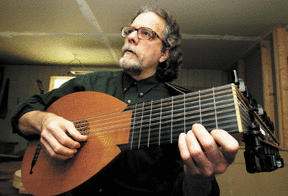Alan Simcoe is building time-travel machines. The island musician and teacher is crafting a
lute and a viola da gamba in his workshop – two Renaissance instruments that, Simcoe says, are guaranteed to transport audiences to the Europe of Michelangelo and the Medicis.
“As instruments for producing music, they are different from modern relatives and not merely mechanically primitive precursors,” Simcoe said. “They are fully functioning time machines…allowing performer and audience to take part in a first-person historic experience.”
Simcoe and Nancy Bergman co-founded the island’s first early music program two years ago to expose islanders to 15th to 17th century European music. Their efforts are under the umbrella of the Island Music Teachers Guild, the three-year-old non-profit supporting music education on Bainbridge.
Simcoe, one of the performers at Sunday’s IMTG fund-raiser for early instruments, received a $2,500 grant from the Bainbridge Island Arts and Humanities Council to craft the two Renaissance instruments.
Simcoe has made instruments since the ninth grade. A long-time member of the Guild of American Luthiers, he studied with Jose Romanillos, Jeff Elliot and other experts. He also learned from the late Bob Lundberg of Portland, Ore., a luthier who, Simcoe says, rediscovered processes lost since the 17th century.
“They were lost because no one’s played these things for a while – since about 1750, when Bach died.”
Simcoe prepared for his current project by researching related instruments and documents in museum collections in Berlin and Goslar, Germany.
The sound of the instruments is markedly different from their contemporary cousins, Simcoe says, because the Renaissance stringed instruments were constructed to emphasize complexity of sound rather than volume.
“A sound that’s complex has overtones,” Simcoe said, “but you trade ‘loud’ for ‘complex.’ Any instrument is confronted by the same two parameters – complexity vs. volume.”
In an era when musicians played in intimate settings for aristocratic audiences, loud was not the favored virtue.
Every step of the construction process of
the instruments is as painstaking today as in 1600.
To bevel the ribs of the lute, Simcoe had to hand-fashion special tools like the rabbit plane, a two-inch long, half-inch wide plane of cherry wood laminated with bone.
The cherry ribs, each two-and-a-half millimeters thick, are bent over pipe, using dry heat.
Simcoe knows from long experience making Torres/Hauser-style classical guitars when the “feel” of the wood indicates that it is heated enough to bend rather than splinter.
Once bent, the ribs for the lute are held in place over the form with large rubber bands until they set.
The lute and viola da gamba are the foundation for what Simcoe plans to develop into an extensive collection of period instruments available for use by the public through the Guild’s early music program.
The Guild, which comprises 18 island music teachers, will store and care for the instruments, Simcoe says, but the public can rent them for a modest fee that will help pay for sheet music and instructional materials.
Simcoe says that period’s polyphonic music, written to be played in small groups, works well for music instruction, because each student must be able to sustain an independent line.
Simcoe notes that his move to start a collection of Renaissance instruments is part of the recent revival of early music.
“I sometimes wonder what would have been if I had begun to make period instruments when I was younger,” Simcoe said. “But 25 years ago, the Guild of American Luthiers didn’t even exist.”
* * * * *
Experience the Renaissance as local musicians play on period instruments 3 p.m. May 19 at Bainbridge Commons. This fund-raising event for the Island Music Teachers Guild early music collection features performances by Alan Simcoe and Nancy Bergman, with community musicians Susan Bray, Barbara Saur, Liam Graham, David Denz and IMTG students. Suggested donations are $15/adults, $5/seniors and students. Information: 842-4120 for more information.



